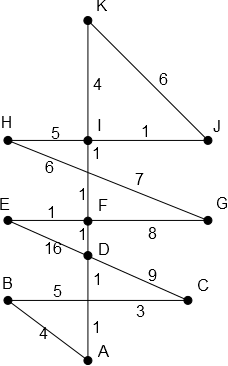2
1
The Scenario
You are a taxi driver in your city. You picked up a passenger from the airport and he told you the place he'd like to go.
To earn more money, you need to drive as much as you can. However, there are two problems:
- He always looks around. Therefore, you cannot pass from the same district twice.
- The passenger is not so dumb. He knows the shortest way between the airport and the destination. Therefore, while you're driving, you should pass each of those districts.
The Input
Input is an undirected and edge weighted graph. The vertices are the districts and the edges are the ways that connect those districts. The weights of the edges indicate the distance between the districts. You can model the graph any way you want.
The Output
Given the source and destination, among with the shortest path, find the longest path that contains each vertex in the shortest path.
The Example
 WHOOPS there are two different edge weights between
WHOOPS there are two different edge weights between B and C.
Source: A
Destination: K
Shortest Path: A-D-F-I-K
Solution: A-B-C-D-E-F-G-H-I-J-K
Rules
- Your solution should be generic and can be applicable to all kinds of connected graphs.
- No cycles are allowed. You can pass through a vertex only once
- Brute-force is not allowed. Don't list all the possibilities and pick among them.
- The edge weights are always positive.
- It is a must to visit all vertices in the shortest path, however, the order is not important.
Duration: 1 week.
Tie breaker: Votes.
The code with the least run-time complexity (in terms of Big-O notation) wins!
Clarification: Do we have to go through the shortest-path nodes in the correct order? Also, are edge weights guaranteed positive? – isaacg – 2014-07-01T00:40:38.417
3I'm pretty sure finding the optimal solution is NP-complete for the same reason Longest Path is. Just reduce from Hamiltonian Path. So, any algorithm is going to be exponential. Moreover, since the reduction doesn't require any blowup, no algorithm can be faster than one for Hamiltonian path, for which the best deterministic algorithm I'm aware of is O(n^2 2^n) – xnor – 2014-07-01T02:11:23.110
1On several edges in your example you gave more than one weight, e.g. B-C has weights 5 and/or 3 without an additional vertex between. – Howard – 2014-07-01T04:39:38.657
@xnor is that a problem? – Martin Ender – 2014-07-01T07:13:57.633
What is the tie breaker if two solutions have the same complexity? – Martin Ender – 2014-07-01T07:14:31.380
@mbuettner clearly, votes – padawan – 2014-07-01T07:52:47.610
1@cagirici "clearly"? No, that is by no means implied by any of the tags you used. Neither is it a common default tie-breaker employed on PPCG. If you want to use votes as the tie breaker, you should specify that in the challenge. – Martin Ender – 2014-07-01T09:21:39.443
@cagirici If a brute force solution is optimal, that is, if
O(n!)is the minimum runtime, is it allowed? Or do you know there is a better solution? – isaacg – 2014-07-01T09:29:50.803@m.buettner NP completeness isn't necessarily a problem, but it pushes the competition into the exponential time and limits the possibility of an algorithm significantly better than brute force, which I find less interesting, but YMMV. It also increases the odds that the brute force O(n!) is the best you can do. – xnor – 2014-07-01T13:05:48.787